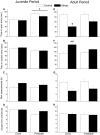Protracted effects of juvenile stressor exposure are mitigated by access to palatable food
- PMID: 24801635
- PMCID: PMC4011852
- DOI: 10.1371/journal.pone.0096573
Protracted effects of juvenile stressor exposure are mitigated by access to palatable food
Abstract
Stressor experiences during the juvenile period may increase vulnerability to anxiety and depressive-like symptoms in adulthood. Stressors may also promote palatable feeding, possibly reflecting a form of self-medication. The current study investigated the short- and long-term consequences of a stressor applied during the juvenile period on anxiety- and depressive-like behavior measured by the elevated plus maze (EPM), social interaction and forced swim test (FST). Furthermore, the effects of stress on caloric intake, preference for a palatable food and indices of metabolic syndrome and obesity were assessed. Male Wistar rats exposed to 3 consecutive days of variable stressors on postnatal days (PD) 27-29, displayed elevated anxiety-like behaviors as adults, which could be attenuated by consumption of a palatable high-fat diet. However, consumption of a palatable food in response to a stressor appeared to contribute to increased adiposity.
Conflict of interest statement
Figures





References
-
- International Obesity Task Force (2010) Obesity: The Global Epidemic. http://www.iaso.org/iotf/obesity/obesitytheglobalepidemic/. Acessed 2013 November 1.
-
- Singh AS, Mulder C, Twisk JW, van Mechelen W, Chinapaw MJ (2008) Tracking of childhood overweight into adulthood: a systematic review of the literature. Obes Rev 9: 474–488. - PubMed
-
- Whitaker RC, Wright JA, Pepe MS, Seidel KD, Dietz WH (1997) Predicting obesity in young adulthood from childhood and parental obesity. N Engl J Med 337: 869–873. - PubMed
Publication types
MeSH terms
Substances
Grants and funding
LinkOut - more resources
Full Text Sources
Other Literature Sources
Medical
Miscellaneous

